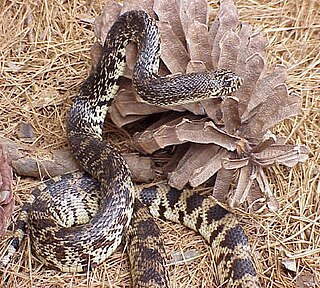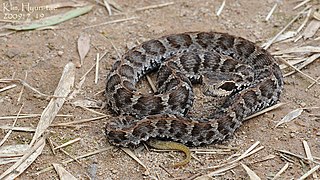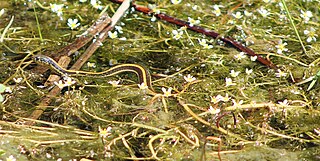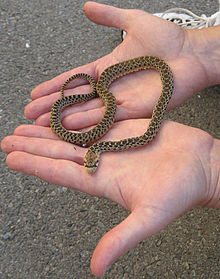
The southern alligator lizard is a common species of lizard in the family Anguidae. The species is native to the Pacific coast of North America. It ranges from Baja California to the state of Washington and lives in a variety of habitats including grasslands, chaparral, forests, and even urban areas. In dry climates, it is likely to be found in moist areas or near streams. There are five recognized subspecies.

Rhacodactylus leachianus, commonly known as the New Caledonian giant gecko,Leach's giant gecko,Leachianus Gecko, or simply Leachie, is a large species of gecko in the family Diplodactylidae. The species, which was first described by Georges Cuvier in 1829, is endemic to New Caledonia.

Pituophis catenifer is a species of nonvenomous colubrid snake endemic to North America. Nine subspecies are currently recognized, including the nominotypical subspecies, Pituophis catenifer catenifer, described here. This snake is often mistaken for the prairie rattlesnake, but can be easily distinguished from a rattlesnake by the lack of black and white banding on its tail and by the shape of its head, which is narrower than a rattlesnake's.

Macrovipera lebetinus, known as the blunt-nosed viper, Lebetine viper, Levant viper, and by other common names, is a viper species found in North Africa, much of the Middle East, and as far east as Kashmir. Like all other vipers, it is venomous. Five subspecies are currently recognized, including the nominate race described here.

Pituophis catenifer affinis, commonly known as the Sonoran gopher snake, is a nonvenomous subspecies of colubrid snake that is endemic to the southwestern United States. It is one of six recognized subspecies of the gopher snake, Pituophis catenifer.

Arizona elegans philipi, commonly known as the Painted Desert glossy snake, is a subspecies of glossy snakes, a nonvenomous colubrid endemic to North America.

The Cape gopher snake or Baja gopher snake is a species of nonvenomous colubrid snake endemic to extreme southern Baja California Sur, Mexico. They have become increasingly popular companions for people interested in the exotic pet trade, due to their extreme color variations and relatively docile behavior. It was previously considered to be a subspecies of Pituophis catenifer. There has been controversy whether the Baja Gopher Snake is a lower classification of the Cape Gopher Snake. Some say the Baja Gopher Snake should be in a separate sub-species of Pituophis Vertebralis Bimaris, while Cape Gopher Snakes should remain Pituophis Vertebralis Vertebralis. Many people mistake the two as the same sub species and have cased some cross-breeding between the two. In captivity the bloodlines are nearly all related and breeding has become especially difficult in terms of keeping the bloodlines alive.

Pituophis melanoleucus, commonly known as the pine snake, is a species of nonvenomous snake in the family Colubridae. The species is endemic to the southeastern United States. Three subspecies are currently recognized as being valid.

The Louisiana pine snake is a species of large, nonvenomous, constrictor in the family Colubridae. This powerful snake is notable because of its large eggs and small clutch sizes. The Louisiana pine snake is indigenous to west-central Louisiana and East Texas, where it relies strongly on Baird's pocket gophers for its burrow system and as a food source. The Louisiana pine snake is rarely seen in the wild, and is considered to be one of the rarest snakes in North America. The demise of the species is due to its low fecundity coupled with the extensive loss of suitable habitat - the longleaf pine savannas in the Gulf coastal plain of the southeastern United States. Management activities are being conducted to promote the species' recovery.

Gloydius brevicauda is a venomous pitviper species endemic to China and the Korean Peninsula.

Bothrops punctatus is a venomous pitviper species found in Ecuador, Mostly in the Chocó Department in Western Colombia and Panama. No subspecies are currently recognized.

The aquatic garter snake is a species of colubrid snake. Three subspecies are currently recognized.

Pituophis catenifer deserticola, commonly known by its standardized English name since the 1950s, the Great Basin gophersnake, is a subspecies of nonvenomous colubrid snake ranging in parts of western United States and adjacent southwestern Canada.

The bullsnake is a large, nonvenomous, colubrid snake. It is a subspecies of the gopher snake. The bullsnake is one of the largest/longest snakes of North America and the United States, reaching lengths up to 8 ft.
Wyoming is home to 12 amphibian species and 22 species of reptiles.

Pituophis deppei, commonly known as the Mexican bullsnake and the Mexican pine snake, is a species of nonvenomous colubrid snake endemic to Mexico. There are two recognized subspecies.
















